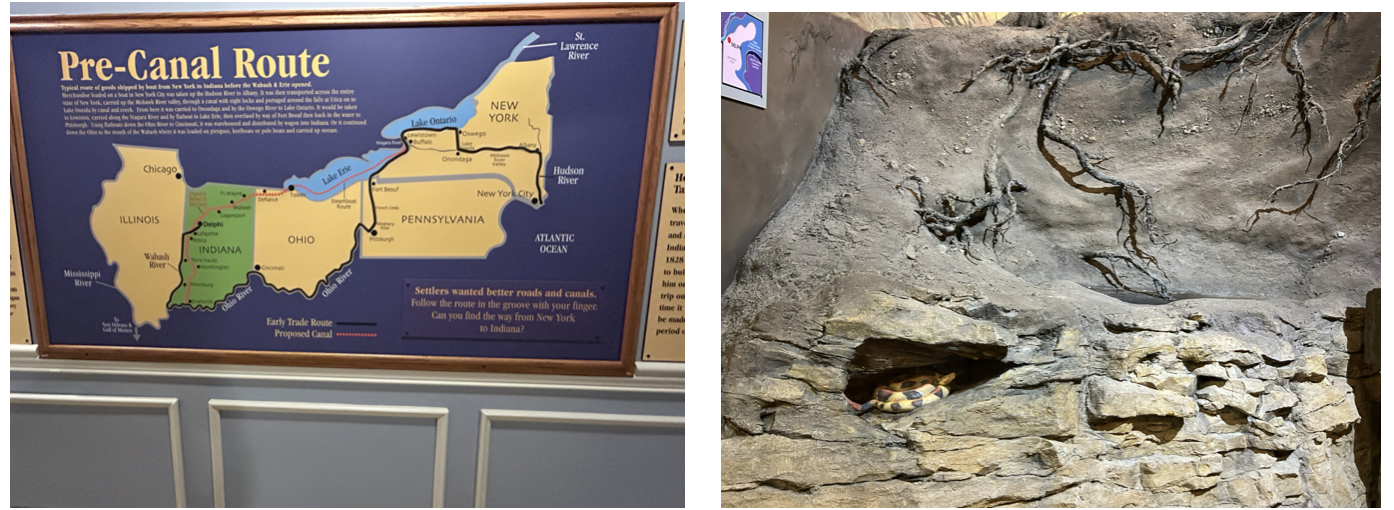The Canal System
By Four Walls
@FourWalls (76712)
United States
July 15, 2025 9:12pm CST
One of the displays in the Wabash and Erie Canal Museum is the pictured replica of the ground that had to be dug out to create the canal system. If you look closely in the left-hand corner you'll see a snake. They had the sound of a rattle playing in the room to give you an indication of the hidden dangers of building the canal system.
There was, of course, an inherent danger of working then: no labor laws, no unions, and no modern equipment. Much of canal was dug with hoes and shovels. The rattlesnakes were probably the most obvious danger, but there were other things as well, such as mosquitoes and ticks.
And that canal was LONG: at 468 miles, it was the longest canal ever built in the United States, and second longest in the world (behind the Grand Canal in China). The photo on the left shows the path of the canal, from the Ohio-Indiana border down to the Ohio River at Evansville.
All the while they were digging this, the railroad was also being constructed. Both came with a high loss of life (I couldn't find an accurate fatality count for workers on the Wabash & Erie Canal [an old marker in Evansville says that "one worker died for every 6 ft of the canal," which would have put the death toll at over 303,000!], but the Erie Canal's worker death toll was over 1,000; meanwhile, over 1,200 known fatalities occurred during the construction of the Intercontinental Railroad). However, the railroad had a major advantage over the canal: it did not require the constant maintenance that the canal did. The canals had to be kept at the set depth (four feet) for the boats. If silt (or, as the narrator on the boat said, trash) accumulated in the canal, it had to be cleaned out. Plus, the locks and dams also had to be constantly repaired. Railroads weren't as demanding for their upkeep.
As I mentioned yesterday, the additional problem with the waterways is that it required repeated transferring the goods being shipped from one boat to another. That wasn't the case with the railroad. And, of course, there wasn't the need for the animals to tow a train the way there was with the barges down the canals.
As a result, the modern marvel that was the Wabash and Erie Canal lost its prominence to the railroad. That's not to say it was a "failure." During its operation, it was a roaring success, helping many of the towns (like Delphi, where the Wabash & Erie Canal Park is located) spring up and thrive. Passenger trains in America have suffered a similar fate thanks to automobiles. Transportation moved on.
But the history is still there!
PHOTOS:
(left) A map showing the canal route through New York, Pennsylvania, Ohio, and into Indiana
(right) A recreation of a trench that would have been dug through for the canal, including the obstacles such as the deep tree branches, limestone, and snakes.
5 people like this
5 responses
@LooeyVille (57)
• United States
Just now
I got to thinking last night - - - I wonder if the tunnels that Harriet Tubman used to free the slaves are open to the public for viewing or still exist? Do you know?
@DaddyEvil (153352)
• United States
6h
I can't imagine all the labor that went into digging the canal by hand... Can you imagine the sore muscles and backs those guys suffered from every day?










